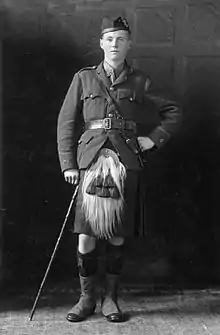Francis Douglas, 11th Marquess of Queensberry
Francis Archibald Kelhead Douglas, 11th Marquess of Queensberry (17 January 1896 – 27 April 1954), also styled Earl of Queensberry and Viscount Drumlanrig in the peerage of Scotland and Lord Douglas of Hawick and Tibbers as a baronet of Nova Scotia, was a Scottish soldier, stockbroker and author.[1]
Marquess of Queensberry | |
|---|---|
 Lord Queensberry, then Viscount Drumlanrig, during the First World War | |
| Scottish representative peer in the House of Lords | |
| In office 16 November 1922 – 10 May 1929 | |
| Personal details | |
| Born | 17 January 1896 Kingston upon Thames, Surrey |
| Died | 27 April 1954 (aged 58) Folkestone, Kent |
| Spouse(s) |
|
| Children |
|
| Parents |
|
| Alma mater | Royal Military Academy Sandhurst |
| Awards | |
| Military service | |
| Allegiance | |
| Branch/service | |
| Years of service | 1915-1919 (active), 1920-1927 (Territorial and Army Volunteer Reserve) |
| Rank | Captain |
| Unit | Royal Highlanders |
| Conflict | World War I |
Biography
Douglas was born in Kingston upon Thames, Surrey, the eldest son of Percy Sholto Douglas, 10th Marquess of Queensberry and his first wife, Anna Maria Walters (1866-1917).[1]
He was educated at Harrow School and the Royal Military College, Sandhurst. He enlisted with the 2nd Battalion, Black Watch[1] of the Royal Highlanders as a second lieutenant in January 1915. During the First World War he served on the Western Front and was promoted to lieutenant in October 1915 and to captain in November 1917. During his service, he suffered from severe appendicitis, diphtheria, and temporary paralysis. Following the recommendation of the Medical Board, he was granted permission by the War Office to travel to the United States during his leave in 1916. Upon his return to the Western Front he received a gunshot wound to the leg. He applied to relinquish his commission, on account of wounds received in action, in November 1919.[2]
After the war he became a stockbroker, dealing mostly in gold and diamond shares from South Africa,[1] and was a member of the London Stock Exchange.[2]
Following the death of his father in 1920, he succeeded him as Marquess of Queensberry. From 1922 to 1929 he was a Scottish representative peer in the House of Lords.[2]
In 1927, he resigned his commission from the Regular Army Reserve of Officers.[2]
In 1938, Queensberry worked to establish a sport and recreation club at Earls Court, to provide a facility for working people that matched those of the upper class. Britain's entry into war with Germany in 1939 called for a change of plans. Closed since 1940 due to the Blitz, the Prince Edward Theatre re-opened in 1942 as the Queensberry All-Services Club, where servicemen and women could enjoy dancing, table tennis, billiards, chess, and variety shows. Queensberry himself actively supported the club by working in it as a receptionist and waiter.[1]
He wrote two books relating to his family history: The Sporting Queensberrys (1942) and with Percy Colson, Oscar Wilde and the Black Douglas (1949).[3][4] Just prior to his birth, his grandfather, John Douglas, 9th Marquess of Queensberry, had been the defendant in the notorious libel action brought by Oscar Wilde, ultimately leading to Wilde's imprisonment.
Family
Lord Queensberry was married three times. He married his first wife, Irene Clarice Richards, the only daughter of H. W. Richards.[1] on 4 December 1917. They had one daughter:
- Lady Patricia Sybil, born 24 December 1918. Married firstly in 1938 Count John Gerard de Bendern (divorced 1950), and secondly in 1950 (divorced 1960) Hermann Hornak.[2]
The couple divorced in 1925. She remarried Sir James Dunn, 1st baronet, and became the mother of painter Anne Dunn.
His second wife was painter Cathleen Sabine Mann, daughter of portrait artist Harrington Mann (married 18 March 1926, divorced 1946).[5] The couple had two children:
- Lady Jane Katherine, born 18 December 1926, married 1949 (divorced 1958) David Arthur Cory-Wright,[2] of the Cory-Wright baronets
- Lord David Douglas, 12th Marquess of Queensberry, born 19 December 1929
His third wife was Muriel Beatrice Margaret Chunn (known as "Mimi"), daughter of Arthur John Rowe Thornett of Monte Carlo,[3] and former wife of Albert Sydney Gore Chunn.[2] They married in 1947 and had one son:
The Marquess died, aged 58, in 1954. His funeral was held at the Friary Church of St Francis and St Anthony, Crawley on 1 May[6] with a requiem mass held 13 May at Farm Street Church in London.[7]
His eldest son David, Viscount Drumlanrig, succeeded him as Marquess. The dowager Marchioness died in 1992.[1][2]
References
- "Obituary: Lord Queensberry". The Times. The Times Digital Archive. 28 April 1954. p. 11.
- Burke's Peerage and Baronetage, Volume 2, 106th Edition. Burke's Peerage (Genealogical Books) Ltd. 1999. p. 2331. ISBN 2-940085-02-1.
- Who Was Who, 1951-1960. A. and C. Black. 1961. p. 898.
- The Oxford Dictionary of National Biography, Volume 16. Oxford University Press. 2014. p. 696. ISBN 978-0-19-861366-4.Bibliography to article on 9th Marquess by John Davis.
- "Sitters A to Z". Cathleen Sabine Follett (née Mann) (1896-1959). National Portrait Gallery. 2012. Retrieved 8 October 2012.
- "Funerals: Marquess of Queensberry". The Times. The Times Digital Archive. 3 May 1954. p. 8.
- "Requiem Masses". The Times. The Times Digital Archive. 14 May 1954. p. 8.
| Peerage of Scotland | ||
|---|---|---|
| Preceded by Percy Douglas |
Marquess of Queensberry 1920 – 1954 |
Succeeded by David Douglas |